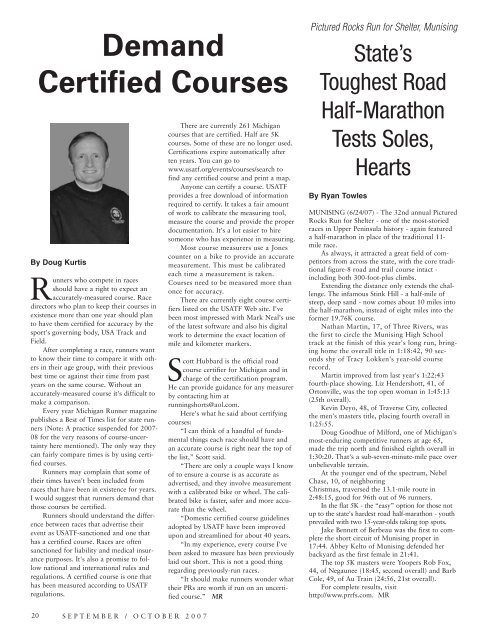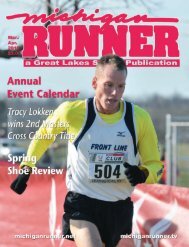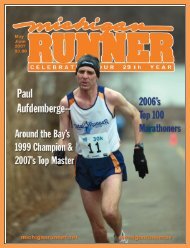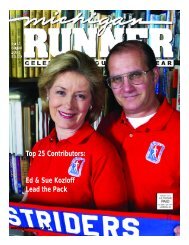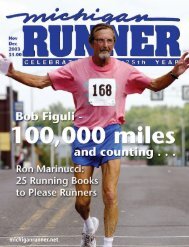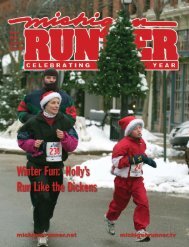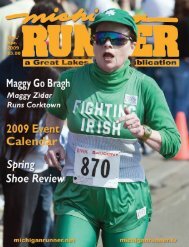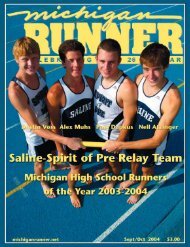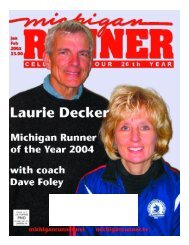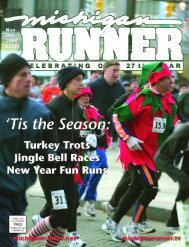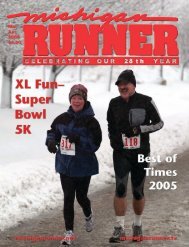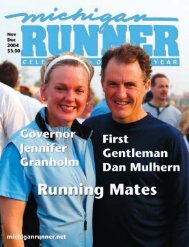Create successful ePaper yourself
Turn your PDF publications into a flip-book with our unique Google optimized e-Paper software.
By Doug Kurtis<br />
<strong>Runner</strong>s who compete in races<br />
should have a right to expect an<br />
accurately-measured course. Race<br />
directors who plan to keep their courses in<br />
existence more than one year should plan<br />
to have them certified for accuracy by the<br />
sport's governing body, USA Track and<br />
Field.<br />
After completing a race, runners want<br />
to know their time to compare it with others<br />
in their age group, with their previous<br />
best time or against their time from past<br />
years on the same course. Without an<br />
accurately-measured course it's difficult to<br />
make a comparison.<br />
Every year <strong>Michigan</strong> <strong>Runner</strong> magazine<br />
publishes a Best of Times list for state runners<br />
(Note: A practice suspended for 2007-<br />
08 for the very reasons of course-uncertainty<br />
here mentioned). The only way they<br />
can fairly compare times is by using certified<br />
courses.<br />
<strong>Runner</strong>s may complain that some of<br />
their times haven't been included from<br />
races that have been in existence for years.<br />
I would suggest that runners demand that<br />
those courses be certified.<br />
<strong>Runner</strong>s should understand the difference<br />
between races that advertise their<br />
event as USATF-sanctioned and one that<br />
has a certified course. Races are often<br />
sanctioned for liability and medical insurance<br />
purposes. It's also a promise to follow<br />
national and international rules and<br />
regulations. A certified course is one that<br />
has been measured according to USATF<br />
regulations.<br />
Demand<br />
Certified Courses<br />
There are currently 261 <strong>Michigan</strong><br />
courses that are certified. Half are 5K<br />
courses. Some of these are no longer used.<br />
Certifications expire automatically after<br />
ten years. You can go to<br />
www.usatf.org/events/courses/search to<br />
find any certified course and print a map.<br />
Anyone can certify a course. USATF<br />
provides a free download of information<br />
required to certify. It takes a fair amount<br />
of work to calibrate the measuring tool,<br />
measure the course and provide the proper<br />
documentation. It's a lot easier to hire<br />
someone who has experience in measuring.<br />
Most course measurers use a Jones<br />
counter on a bike to provide an accurate<br />
measurement. <strong>This</strong> must be calibrated<br />
each time a measurement is taken.<br />
Courses need to be measured more than<br />
once for accuracy.<br />
There are currently eight course certifiers<br />
listed on the USATF Web site. I've<br />
been most impressed with Mark Neal's use<br />
of the latest software and also his digital<br />
work to determine the exact location of<br />
mile and kilometer markers.<br />
Scott Hubbard is the official road<br />
course certifier for <strong>Michigan</strong> and in<br />
charge of the certification program.<br />
He can provide guidance for any measurer<br />
by contacting him at<br />
runningshorts@aol.com.<br />
Here's what he said about certifying<br />
courses:<br />
“I can think of a handful of fundamental<br />
things each race should have and<br />
an accurate course is right near the top of<br />
the list,” Scott said.<br />
“There are only a couple ways I know<br />
of to ensure a course is as accurate as<br />
advertised, and they involve measurement<br />
with a calibrated bike or wheel. The calibrated<br />
bike is faster, safer and more accurate<br />
than the wheel.<br />
“Domestic certified course guidelines<br />
adopted by USATF have been improved<br />
upon and streamlined for about 40 years.<br />
“<strong>In</strong> my experience, every course I've<br />
been asked to measure has been previously<br />
laid out short. <strong>This</strong> is not a good thing<br />
regarding previously-run races.<br />
“It should make runners wonder what<br />
their PRs are worth if run on an uncertified<br />
course.” MR<br />
Pictured Rocks Run for Shelter, Munising<br />
State’s<br />
Toughest Road<br />
Half-Marathon<br />
Tests Soles,<br />
Hearts<br />
By Ryan Towles<br />
MUNISING (6/24/07) - The 32nd annual Pictured<br />
Rocks Run for Shelter - one of the most-storied<br />
races in Upper Peninsula history - again featured<br />
a half-marathon in place of the traditional 11-<br />
mile race.<br />
As always, it attracted a great field of competitors<br />
from across the state, with the core traditional<br />
figure-8 road and trail course intact -<br />
including both 300-foot-plus climbs.<br />
Extending the distance only extends the challenge.<br />
The infamous Stink Hill - a half-mile of<br />
steep, deep sand - now comes about 10 miles into<br />
the half-marathon, instead of eight miles into the<br />
former 19.76K course.<br />
Nathan Martin, 17, of Three Rivers, was<br />
the first to circle the Munising High School<br />
track at the finish of this year's long run, bringing<br />
home the overall title in 1:18:42, 90 seconds<br />
shy of Tracy Lokken's year-old course<br />
record.<br />
Martin improved from last year's 1:22:43<br />
fourth-place showing. Liz Hendershott, 41, of<br />
Ortonville, was the top open woman in 1:45:13<br />
(25th overall).<br />
Kevin Deyo, 48, of Traverse City, collected<br />
the men's masters title, placing fourth overall in<br />
1:25:55.<br />
Doug Goodhue of Milford, one of <strong>Michigan</strong>'s<br />
most-enduring competitive runners at age 65,<br />
made the trip north and finished eighth overall in<br />
1:30:20. That's a sub-seven-minute-mile pace over<br />
unbelievable terrain.<br />
At the younger end of the spectrum, Nebel<br />
Chase, 10, of neighboring<br />
Christmas, traversed the 13.1-mile route in<br />
2:48:15, good for 96th out of 96 runners.<br />
<strong>In</strong> the flat 5K - the “easy” option for those not<br />
up to the state's hardest road half-marathon - youth<br />
prevailed with two 15-year-olds taking top spots.<br />
Jake Bennett of Berbeau was the first to complete<br />
the short circuit of Munising proper in<br />
17:44. Abbey Kelto of Munising defended her<br />
backyard as the first female in 21:41.<br />
The top 5K masters were Yoopers Rob Fox,<br />
44, of Negaunee (18:45, second overall) and Barb<br />
Cole, 49, of Au Train (24:56, 21st overall).<br />
For complete results, visit<br />
http://www.prrfs.com. MR<br />
20 S E P T E M B E R / O C T O B E R 2 0 0 7


